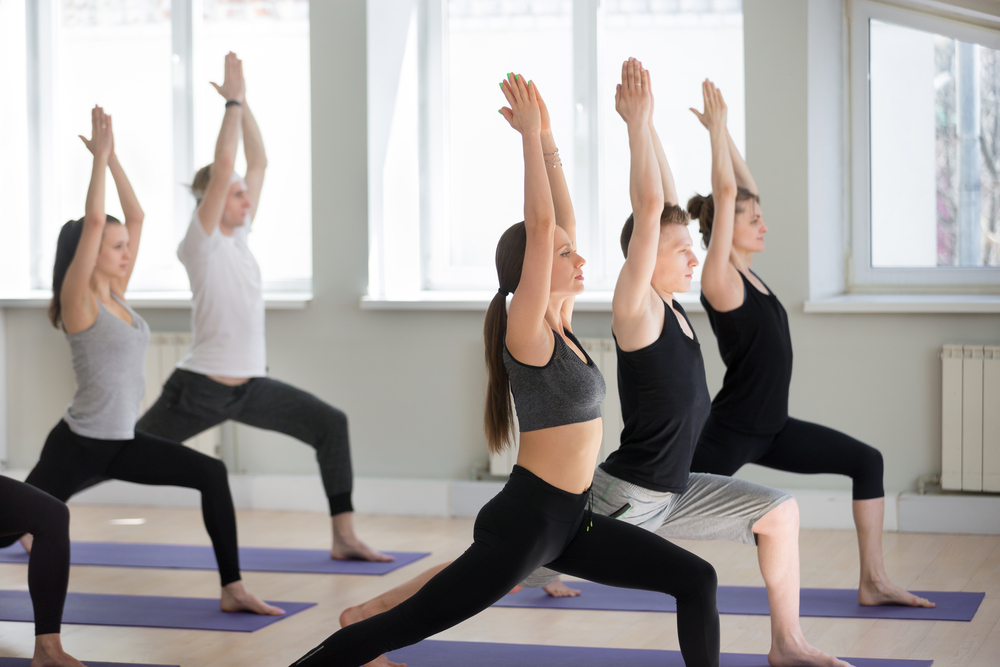If you’ve ever finished a particularly challenging yoga session by collapsing onto the yoga mat drenched in sweat, you’ve likely wondered, “is cardio yoga?” The answer is it can be!
Yoga definitely provides significant health and fitness benefits to practitioners, such as increased flexibility, reduced stress, better balance, and lengthened muscles. But is yoga cardio?
Can yoga provide all the exercise you need, or should you supplement it with other aerobic activities to protect your cardiovascular health?
We’ll answer that question by explaining the requirements to classify as cardio, and we’ll provide some tips on getting that heart rate up during your yoga practice so you can reap all the benefits yoga can provide.
Contents
Defining Cardio
Cardio can be roughly defined as any sustained activity that elevates your heart rate into a range that trains and strengthens your heart.
Cardiovascular, or cardiorespiratory, fitness is one of the most important ways to improve your overall health and longevity. Getting about thirty minutes of cardio at least a few times a week provides numerous benefits to your health.
Cardiovascular exercise can help to prevent heart disease, obesity, diabetes, and possibly certain cancers. Regularly doing cardio can lead to better cognitive functioning and protection against short-term memory loss, sharper focus, weight loss, and overall vitality.
You might also be interested in our anabolic running guide.

The activities that most people commonly think of when they think of cardio are activities like running on a treadmill, cycling, or other aerobic exercises like doing jumping jacks or jumping rope. But any activity that targets large muscle groups using a rhythmic, continuous element could potentially be classified as cardio.
A good cardio workout increases your heart rate, causes you to break a sweat, uses your major muscle groups, and promotes a healthy heart.
Cardio exercise should ideally increase the need for oxygen and elevate your heart rate to a specific target level, which is at least sixty to seventy percent of your max heart rate.
So is yoga cardio? Let’s take a closer look.
Yoga As Exercise
The practice of yoga has been around for over 5,000 years, and the word yoga roughly means “unity,” or to yoke or bind. It is a discipline method for yogis that uses physical postures designed to build strength and stamina, purify the body, and prepare it for long periods of meditation.
There are definite science-backed health benefits to practicing yoga. Yoga stretches your entire body and increases your flexibility as your muscles gradually loosen and lengthen.
You can experience decreased aches and pains from improved posture and loosened joints. Your own body weight helps to develop stronger muscles and more graceful movement as you work through poses.
Yoga can also help strengthen your bones and protect you against osteoporosis by strength training your arms, hands, and wrists. The variety of movements gives your joints a chance to use their full range of motion, which massages the cushions between neglected joints and prevents degenerative arthritis.
The movements, along with the mindfulness, can decrease cortisol, the stress hormone, which can leach calcium from the bones. Yoga is an excellent practice for lowering high blood pressure and improving circulation by increasing the blood flow.
Twisting motions increase lymph drainage to help you fight infection, destroy cancer cells, and eliminate waste from the body. By keeping you focused on the present and increasing serotonin levels, consistent yoga practice can even help fight depression and fatigue.
With all these benefits, it seems like the only exercise you’d ever need, but can yoga check off the necessary requirements to classify as cardio?
Is Yoga Cardio?
Let’s go back. An activity requires three factors to classify as cardio: intensity, duration, and frequency. So the intensity of your yoga practice, the duration of your practice, and how often you practice will ultimately determine if your yoga session can count as cardio.
In general, if you primarily do gentle yoga styles, like restorative yoga, you will likely never get your heart rate into the optimal range to count as a cardio workout. But there are more physically demanding and movement-focused styles of yoga that very well can.

In order to meet the optimal heart rate range for cardio, your heart rate needs to reach at least 60 to 70 percent of your max heart rate and stay there for at least twenty minutes. You can determine a rough estimate of the ideal range for yourself by subtracting your age from 220.
Once you have your max heart rate, you can determine the correct range that your heart rate must be in for an activity to count as cardio.
In order for your yoga routine to count as a cardio workout, your heart rate will have to get into this range during your practice and stay there for at least twenty minutes. Not all types of yoga will help you achieve this, but it’s definitely possible.
Fast-Paced Yoga as Cardio
The types of yoga that you practice will play a massive role in whether a yoga session counts as cardio. Beginner introductions to yoga and restorative yoga styles pause and hold poses for too long to keep your heart rate up, but fast-paced, high-intensity styles, like power yoga or Ashtanga, may actually get you pretty close to your cardio range.
Whether yoga can be classified as cardio is still a bit of a grey area. Most people believe that even fast-paced yoga workouts won’t give you quite the same effect as far as intensity goes as the more traditional cardio activities, like running or biking. But duration may make up for any lack of intensity.
Many yoga practitioners often practice for much longer durations than most other cardio activities, and at a higher frequency. Science suggests that in terms of overall fitness and heart health, the duration and frequency can make up for the slightly lower intensity.
However, to maintain the cardiovascular benefit, you’ll have to increase the challenge of your practice constantly. As you get stronger and your heart muscles get stronger, the moves and poses will become easier, and your heart rate won’t always get quite as high.
This means it’s working! But to keep receiving cardiovascular benefits, you’ll have to rise to the challenge and continue to push yourself.
Two Aerobic Sequences to Try
For your yoga practice to count as cardio, you’ll need to incorporate a vigorous style into your sessions at least a few times a week. More aerobic styles to try are Ashtanga, Vinyasa, and power yoga. There are even yoga classes you can attend that focus on achieving a cardio effect during the session.

Whatever style you choose, you’ll need to move in a continuous and somewhat rhythmic way that is challenging but sustainable so that you can keep your heart rate up. Wearing a heart rate monitor can tell you if you’re hitting cardio territory.
Here are some sequences to try to get your blood pumping and your heart rate elevated:
Sun Salutation
This yoga sequence uses a series of yoga poses that continuously flow into each other. By incorporating your breathing and getting into a rhythm, Sun Salutation (Surya Namaskar) stretches and loosens up the entire body while getting the blood flowing and raising your heart rate.
You can perform this sequence about five to ten times as a warm-up and as part of your cardio workout.
- Mountain Pose
- Arms Above Head
- Standing Forward Fold
- Half Forward Bend
- Four-Limbed Staff Pose
- Upward-Facing Dog
- Downward-Facing Dog
- Half-Forward Bend
- Standing Forward Fold
- Arms Above Head
- Mountain Pose
Dancing Warrior
The Dancing Warrior is a typical sequence practiced in Vinyasa yoga practices. Just as in Sun Salutation, the key is to flow continuously from one yoga pose into another to get your blood moving and your heart rate elevated.
- Downward-Facing Dog
- Warrior I
- Warrior II
- Reverse Warrior
- Extended Side Angle Pose
- Plank Pose
- Four-Limbed Staff Pose
- Upward-Facing Dog
- Doward-Facing Dog
Sequences like Sun Salutation and Dancing Warrior can be repeated several times and combined to get your heart pumping for at least twenty minutes.
If yoga is your primary source of cardio, remember to practice at least three times a week for at least 30 minutes to an hour. And don’t forget to breathe!
Final Word on Is Yoga Cardio
If you decide to give cardio yoga a try, remember not to let your fitness goals overshadow the other benefits that yoga can provide. Fitness isn’t the only reason to practice yoga. If aerobic exercise is your goal while doing yoga, try wearing a heart monitor to see for sure if you’re getting into the right cardio range.
Beginners may find it challenging to use yoga as a cardio workout while they’re still learning the poses and the proper form. A class in which you can watch a yoga teacher and get guidance is a great place to start.
Look for Ashtanga yoga, Power yoga, or a specific “Cardio Yoga” class. Whether you decide to use yoga as a cardio exercise or not, there’s no denying the benefits of including yoga in your weekly exercise schedule.



